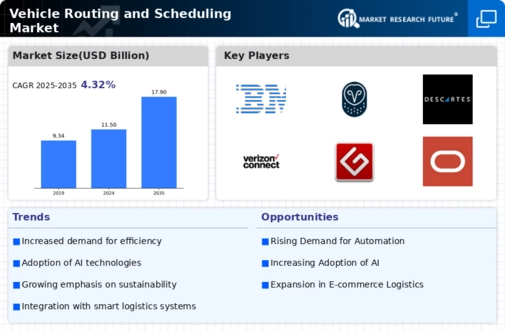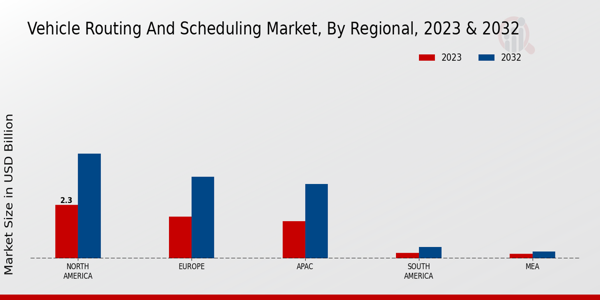Rise of Smart Cities
The emergence of smart cities is significantly impacting the Global Vehicle Routing and Scheduling Market Industry. Urban planners are increasingly integrating technology into city infrastructure, which facilitates better traffic management and enhances public transportation systems. This integration allows for real-time data sharing among vehicles, traffic signals, and routing systems, leading to improved efficiency. As cities adopt smart technologies, the demand for sophisticated routing and scheduling solutions is likely to increase. This trend may contribute to a compound annual growth rate of 4.06 percent from 2025 to 2035, reflecting the growing interconnectivity of urban environments.
Environmental Regulations
The Global Vehicle Routing and Scheduling Market Industry is influenced by stringent environmental regulations aimed at reducing carbon emissions. Governments worldwide are implementing policies that encourage the adoption of greener transportation solutions. For example, regulations may mandate the use of electric vehicles or impose penalties for excessive emissions. In response, companies are turning to advanced routing and scheduling technologies that minimize fuel consumption and emissions. This shift not only helps businesses comply with regulations but also positions them favorably in the eyes of environmentally conscious consumers, thereby driving market growth.
Market Growth Projections
The Global Vehicle Routing and Scheduling Market Industry is projected to experience robust growth over the coming years. With a market value anticipated to reach 11.5 USD Billion in 2024 and 17.9 USD Billion by 2035, the industry is poised for significant expansion. This growth trajectory suggests a compound annual growth rate of 4.06 percent from 2025 to 2035, indicating a sustained demand for innovative routing and scheduling solutions. As businesses increasingly recognize the value of optimizing their logistics operations, the market is likely to evolve, driven by technological advancements and changing consumer expectations.
Technological Advancements
The Global Vehicle Routing and Scheduling Market Industry is experiencing rapid technological advancements, particularly in artificial intelligence and machine learning. These innovations enhance route optimization, reduce fuel consumption, and improve delivery times. For instance, companies are increasingly adopting advanced algorithms that analyze real-time traffic data, which can lead to a reduction in operational costs by up to 20 percent. As businesses strive for efficiency, the integration of these technologies is likely to drive market growth, with the industry projected to reach 11.5 USD Billion in 2024.
Increased Focus on Cost Reduction
Cost reduction remains a primary focus for businesses within the Global Vehicle Routing and Scheduling Market Industry. Companies are continuously seeking ways to minimize operational expenses while maintaining service quality. Efficient routing and scheduling systems can lead to substantial savings by optimizing delivery routes and reducing fuel consumption. For instance, businesses that implement these systems may experience a decrease in logistics costs by as much as 15 percent. As organizations prioritize cost efficiency, the demand for advanced routing solutions is expected to rise, further propelling market growth.
Growing Demand for Efficient Logistics
The Global Vehicle Routing and Scheduling Market Industry is witnessing a growing demand for efficient logistics solutions. As e-commerce continues to expand, companies are under pressure to deliver products quickly and reliably. This trend is particularly evident in urban areas, where traffic congestion can significantly impact delivery times. By implementing effective routing and scheduling systems, businesses can optimize their fleets and enhance customer satisfaction. The market is expected to grow steadily, with projections indicating a value of 17.9 USD Billion by 2035, reflecting the increasing importance of logistics efficiency.
























